

Grey Crowned Cranes



PACE – Pan African Conservation Education was created by Tusk and Siren Conservation Education in 2004.
This booklet on grey crowned cranes was written by Bernard Ndayisaba, RWCA Field officer. It was compiled and produced by Penny Fraser, PACE coordinator, assisted by Providence Uwanyirigira, RWCA Field officer. We all thank Cedric Ujeneza, RWCA communication manager, for providing wonderful photographs, and Olivier Nsengimana and Deo Ruhagazi for their expertise, encouragement and open collaborative spirit. Design and layout was by Katie Puremont.
Published by Tusk Trust, 4 Cheapside House, Gillingham, Dorset SP8 4AA, UK
© 2025 Tusk Trust & Rwanda Wildlife Conservation Association, RWCA.
First published 2025.
A catalogue record for this booklet is available from the British Library.
ISBN 978-1-0684834-0-0
Moral rights of the authors have been asserted. All rights reserved. The authors have made every effort to ensure the accuracy and currency of the information in this publication.

PACE – Pan African Conservation Education
PACE is an education programme of Tusk. It was set up in 2004, and its conservation education materials have reached more than 1.6 million people.
PACE is about helping people solve their everyday environmental problems, especially problems that impact on their wellbeing, and on the wildlife and eco-systems we all depend on.
Our educational resources are free. They are arranged in modules: Living with Wildlife, Water, Soil, Trees, Energy, Living by the Ocean, Urban Living, Health and Careers in Conservation.
We work with conservation partners across Africa, helping people reconnect with nature, to understand, value and protect it. This resource on grey crowned cranes is part of the Living with Wildlife module.
Why grey crowned cranes?
Grey crowned cranes are tall, majestic birds, a symbol of wealth and longevity. Unfortunately this caused them to become endangered over the last 20 years, especially so in Rwanda. The pet trade, on top of habitat loss, poaching for food, poisoning and egg collection, was devastating.
In 2014 RWCA started a campaign to protect Rwanda’s cranes and their habitats. They have had huge success. This booklet was produced to support their ongoing conservation work raising awareness of the value and beauty of cranes, and engaging communities in conservation. It will be useful Africa wide, in schools and for general reading, to help us all better understand and care for these beautiful creatures.
Photo: © John Dickens
RWCA – Rwanda Wildlife Conservation Association
RWCA is a Rwandan conservation organisation started in 2014 by a team of young Rwandan vets and wildlife conservationists. Their goal was to abolish the illegal trade in Rwanda’s endangered grey crowned cranes, and they have largely succeeded. RWCA now employs more than 250 people at various conservation sites across the country. RWCA’s activities include conservation, research, education and community development work. It also set up a nature reserve in Kigali as a home for disabled grey crowned cranes that would not survive in the wild. It is called Umusambi Village and has many visitors who come to see the cranes and learn about conservation and the importance of wetlands.
RWCA research and conservation efforts now includes many endangered and threatened species and habitats. They work with and for the communities living alongside wildlife, in Rwanda, and the wider East African region.
This booklet is part of a series produced with PACE, about species and habitats that are important in Rwanda and elsewhere in Africa. It was created with RWCA Conservation champions and Conservation club mentors and members in mind, but will also be useful in schools, homes and for any general reading. By partnering with PACE RWCA expertise and experience reaches and helps people in countries Africa wide.
‘Umusambi’ is the word for Grey Crowned Crane in Kinyarwanda, the language of Rwanda.
Grey Crowned Cranes
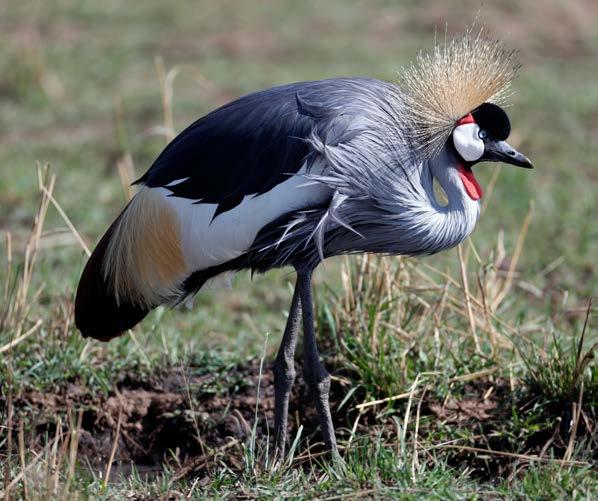
There are 15 species of crane in the world. There are six species in Africa, and four of those are only found in Africa – the grey crowned, black crowned, wattled and blue cranes. This booklet is about the grey crowned cranes. There are photos of the other species on pages 30-34.
Taxonomy
Kingdom: Animalia
Phylum: Chordata
Class: Aves – birds
Order: Gruiformes
Family: Gruidae – Cranes
Genus: Balearica
Spp: Balearica regulorum – Grey crowned crane
Appearance
The body of grey crowned cranes is grey, with a black tail. The wings are white, with black primary feathers and brown secondary feathers. The neck is light grey, with a red wattle. The face is black, with white cheeks that have red above. It has a distinctive golden yellow crown on the top of its head. They have long, black coloured legs.
Size – Mature grey crowned cranes are about 1.2m tall.
Wingspan is 1.8-2m.
Weight is 3-4kg. Males can be slightly bigger than females, but it is very difficult to know if a crane is male or female. Even their behaviours are the same. The only accurate way is DNA sexing.
Juveniles are normally grey, with a brown crown and nape and grey to brown body. They have a brown iris.
DNA sexing uses a sample of blood. A DNA test can show if the blood came from a female or male.


Physical
body parts of a grey crowned crane

Primary flight feathers
Secondary flight feathers
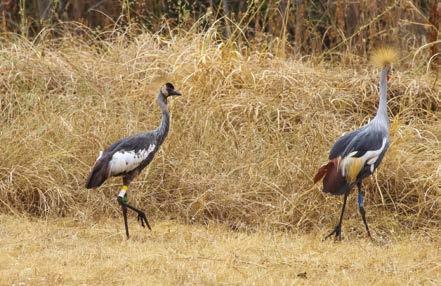
Wing
Feet
Neck
Legs
Crown
Wattle
Beak
Photo: © Will Wilson
Juvenile and adult

Grey crowned cranes are one of the two species of cranes (grey crowned cranes and black crowned cranes) that can roost in trees.
Wattle – fleshy skin that hangs. On birds it is usually on the neck or head. It is ornamental, to attract mates.
Grey crowned cranes have a red wattle on their neck. Cockerels have a wattle on their chins and heads.
Migration is regularly moving from one place to another according to the season. Some birds fly from Africa to Europe when food is scarce in Africa and plentiful in Europe. They return to Africa when the summer finishes, it gets cold and food is scarce in Europe. Animals migrate to places where the weather, food or breeding conditions are better for them. Grey crowned cranes are not migratory birds.
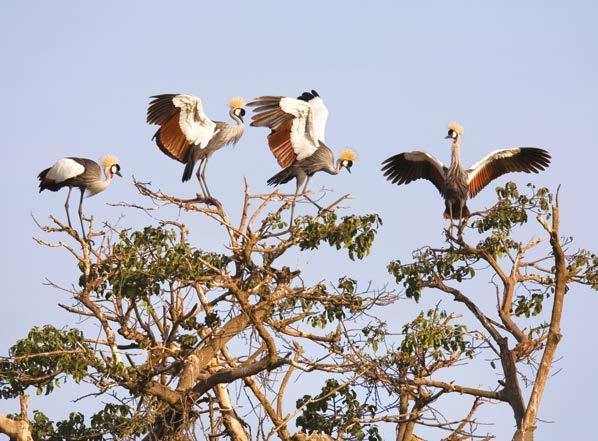
Range
Grey crowned cranes are native to east and southern Africa.
Population
The number of grey crowned cranes in Africa has been decreasing for many years. In Rwanda conservation efforts have given them some protection. The largest populations are in Kenya, Uganda, Zambia, and South Africa. A 2024 census estimated there were 1293 grey crowned cranes in Rwanda.

Habitat
Grey crowned cranes live in mixed wetlands, grassland and savannah. They depend on wetland for nesting. They forage in more open areas and move to roost in trees at night.
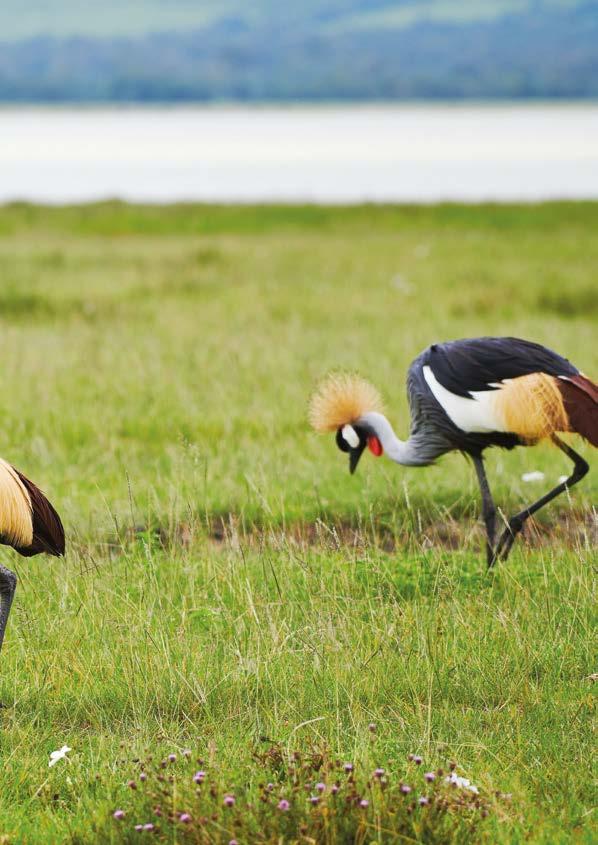
Grey crowned cranes live in natural habitats, but also in pasture, cropland, and irrigated areas. They may be seen feeding in agricultural and other open land.




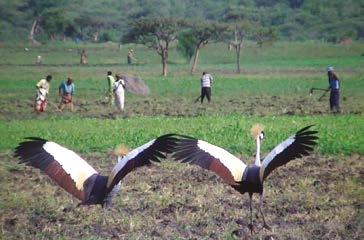
Grey crowned cranes in Akagera National Park
Cranes and farmers
Territory
Grey crowned cranes spend most of their time living in flocks, but in the breeding season couples move away to make their own territory, where they will mate and raise a family. The size of their territory depends on how much food is available. They defend their territory to stop other cranes entering. Grey crowned cranes are only territorial during the breeding season.
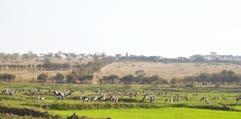
Diet and feeding
Grey crowned cranes are omnivores. They eat plant matter, including fresh parts of grasses, seed heads of sedges, and insects like grasshoppers, locusts and crickets, also worms, lizards, frogs, crabs and eggs of small aquatic creatures.
They will stamp their feet on the ground to disturb insects, which are then quickly consumed. They make rapid pecks to get their food and may uproot plants.
They will follow cattle, antelope and other large mammals, to eat the insects they attract.



• The grey crowned crane is Uganda’s national bird. It is on the country’s coat of arms and flag.
• This bird is a sacred symbol for Kenya, Namibia, Zambia, and South Africa.
A flock of grey crowned cranes in Akagera National Park
Social life
Grey crowned cranes spend most of their time living in flocks. A flock can be from three to more than 300 birds. In the breeding season male and female pairs leave the flock and live in their own small family. At the end of the breeding season, they return to and live with the flock. Nonbreeding birds, eg. those that are not yet mature, stay in the flock all the year.
Sometimes cranes will leave their flock and join a different one.
The role of grey crowned cranes
Grey crowned cranes help keep natural ecosystems healthy and functioning properly:
• By dispersing seeds of plants that they eat.
• Pest control – they eat a lot of insects that are agricultural pests.
• They are cultural symbols and provide inspiration to people who hear and see them. They provide important ecosystem services, that we all depend on.



Crane pair at Umusambi village © Will Wilson
Akagera National Park © Drew Bantlin
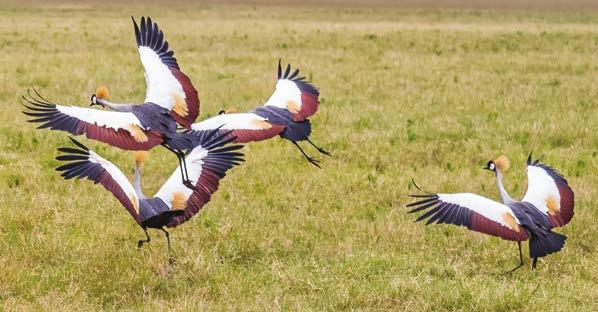
Migration
Grey crowned cranes are not migratory birds but they can move hundreds of kilometres foraging for food or to avoid harsh conditions.
Movement
They fly and walk, and can swim if they need to. Grey crowned cranes can fly long distances. Their long legs mean they can wade in water.

Grey crowned cranes are diurnal – which means active during the day.
A flock of grey crowned cranes at Nygatare

With their long legs and large wings, cranes are not agile fliers. When they want to take off from the ground, they need some metres to run in preparation for take off.
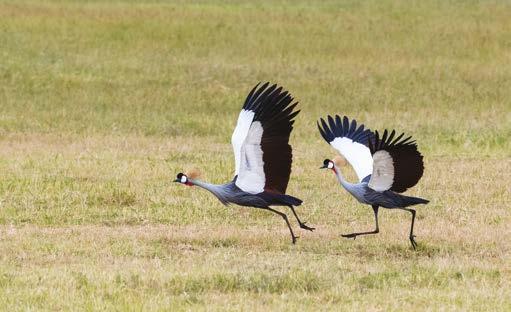
Grey crowned crane flying over Umusambi village © Will Wilson

Courtship
Before mating the male and female will dance, bow and bob for each other – one drops low down, while the other stands tall. Couples dance together and preen one another’s necks. This helps strengthen the bond between them.
Family
A grey crowned crane family has two adults, a male and a female, and 1-4 chicks or juveniles. They are monogamous, and they mate for life. Normally if one of a pair dies, the other will remain single for the rest of its’ life. Exceptionally after some time the widow or widower may take a new mate.
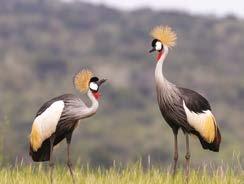

Cranes bobbing at Rugezi Marsh
Photo: © Steve Potter
Photo: © Steve Potter
Reproduction
Grey crowned cranes are sexually mature at three, sometimes two years old. They find a mate, normally from their flock and bond very closely and loyally.
Grey crowned cranes are highly territorial during the breeding season. When they breed depends on weather, specifically the rains. In Rwanda the breeding season is usually in the rainy months, September to early May, when wetlands are less accessible to predators but they can also breed in the dry season.
They are monogamous and stay with the same mate for life.
Breeding couples move away from their flock and build nests in or along the edges of the wetlands. They lay up to four eggs at a time. The nest is made from grass and other plants piled and flattened into a round platform. It is usually hidden amongst the vegetation to protect the eggs from predators.
Once eggs are laid, the couple share the parenting duties. Both male and female take turns sitting on eggs, protecting the nest and raising chicks. Incubation is 28-30 days.
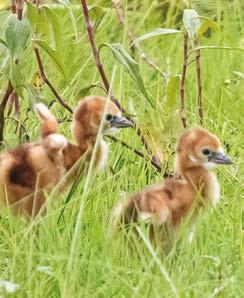
Chicks are brown, with paler, orange brown neck and head, and light coloured wings.
Just one day after being born they start moving with their parents around the nest, feeding themselves.
Chicks are precocial.
Precocial means they move & feed soon after hatching.


Chicks stay near their parents for 3 months. The parents look after them, just like a mother hen. They can start to fly after 2-3 months. They will join the same flock with their parents.


Grey crowned crane sitting on a nest of eggs. Camouflaged by vegetation.
Lifespan
Grey crowned cranes can live for up to 20 years in the wild and 30 years in captivity.
Senses
Grey crowned cranes have good sight. They hear, and they have a sense of smell. To find food, and detect danger they mostly use sight and sound.
Communication
Grey crowned cranes mostly communicate vocally, by calls, but also using posture and behaviours.
They use one call when they are socialising, another when there is an intruder, and another when they are mating.
The main call is a low pitched honking. Once mated a pair will call simultaneously, a behavior known as unison calling. These calls are like singing together, and strengthen the bond between a male and female. It also tells rival cranes and other potential threats to give the couple some space.
If an intruder gets close, the cranes may turn to more visual displays. They can fight another crane that intrudes on their territory. They fight with their beak and legs.
CLICK HERE to listen to the low pitched honking call of the grey crowned crane.
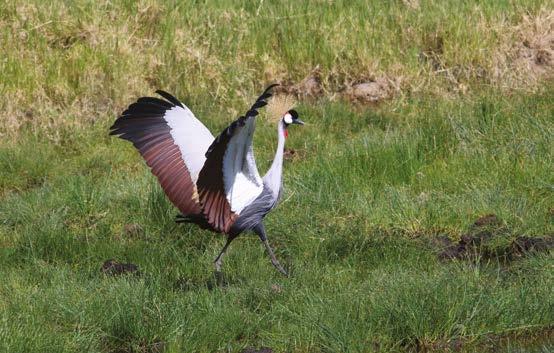


Predators
The young chicks can fall victim to birds of prey, like eagles. A martial eagle can even prey on adult cranes. Snakes and monitor lizards can predate on eggs. Mongoose will prey on eggs and chicks.
Human induced threats
Poaching of young chicks for the pet trade has been very harmful to grey crowned cranes. This is called wildlife trafficking, and it is illegal.
Grey crowned cranes have also been hunted in the past, by trapping birds, and also collecting eggs for trade. All these activities are illegal.
Habitat loss. Wetlands that cranes need for breeding are being lost. They are sometimes drained, built on, or converted to agricultural farmland.
Habitat degradation. Overgrazing wetlands means there are less food species for cranes and less cover to hide their nests.
Pesticide pollution harms the cranes.
Poisoning and hunting cranes for food are also problems.
Cranes thrive in habitat with lots of native species.
It is illegal to capture or keep grey crowned cranes, or their eggs.
Conservation of grey crowned cranes
In Rwanda grey crowned cranes became close to disappearing. When RWCA started its work 2014 there were less than 500 birds left in the wild. Many people did not know that cranes were endangered. Many people didn’t know about the laws protecting cranes. They didn’t know it was wrong to collect, buy or sell cranes or crane eggs.
People did not realise that wild cranes help keep our environment healthy.
Conservation education
RWCA – Rwanda Wildlife Conservation Association - works with government and with local communities. They teach people about cranes and how to live alongside wildlife without harming it. Now children grow up knowing not to collect crane eggs, not to eat or to sell.
Rescue and release
Cranes that are kept as pets or for display are usually stressed and malnourished, often have their wings broken to stop them flying, can’t breed and die prematurely.
In Rwanda it is illegal to keep cranes as pets. RWCA rescued cranes that were being kept as pets and helped them back to good health. Tags were put on their legs so they can be monitored, and they were taken back to the wild to live freely. Any that were disabled, unable to fly, or not strong were given a new home at Umusambi Village, a beautiful safe and protected wetland and nature reserve.


Students visiting Umusambi Village



Many visitors enjoy the environment at Umusambi Village where they learn about cranes and conservation.
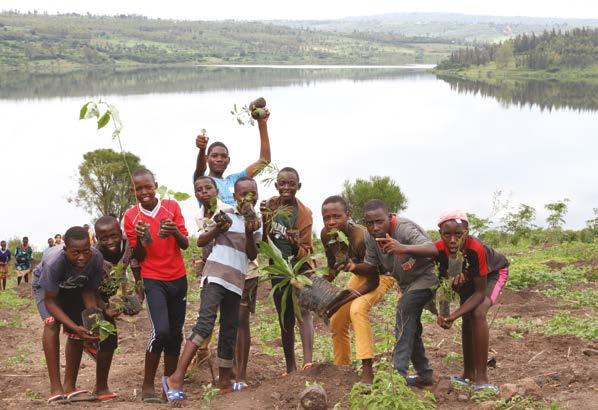
Protecting and restoring habitats
RWCA helps people to improve their standard of living while protecting cranes and their habitat. Farmers are planting fodder grass instead of collecting from the marshes. They know not to pollute streams and lakes. They can care for cattle without overgrazing the wetlands.
People are planting and growing native trees instead of just harvesting them.
To restore something is to make it as it used to be.

Employment
Rwanda’s cranes have created jobs and careers for many people. As well as vets and conservationists, RWCA employs hundreds of local people as rangers, as educators, as community conservation champions and as field technicians.
There are lots of different jobs at Umusambi Village. People work in the tree nursery, look after injured wildlife, do research, security or maintenance. Others welcome visitors or work in the cafe. There is also office work in finance, computers, fundraising, and communications.




All RWCA staff 2023


RWCA monitors the wild cranes and do a regular census. A census is a count. It is done during flocking time, when all the birds are together.
The censuses show that grey crowned crane conservation is doing well. Every year since 2017 the number of cranes in Rwanda has increased.

What can we do?
Be the voice of cranes.
Pass on what we’ve learned. Help people appreciate cranes in the wild, protect their habitats and stop any poaching of eggs or birds.
It is illegal to capture, kill or keep a grey crowned crane, or its egg.
Be the voice of cranes!
Black crowned crane
Balearica pavonina


Wattled crane
Bugeranus carunculatus
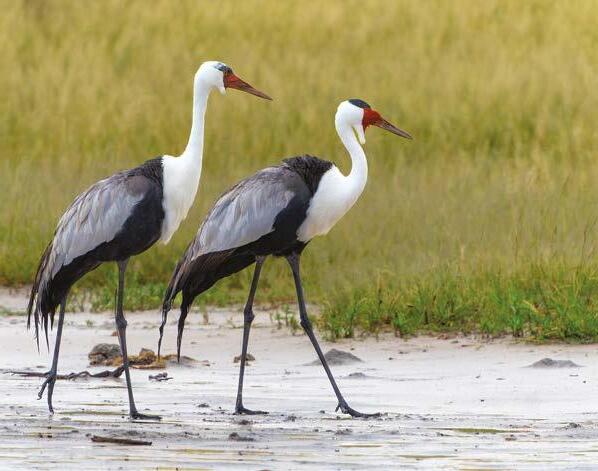
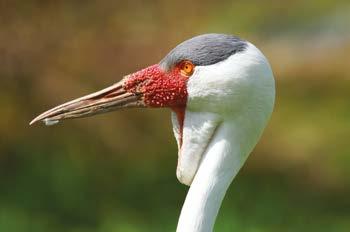
Anthropoides paradiseus

Blue crane
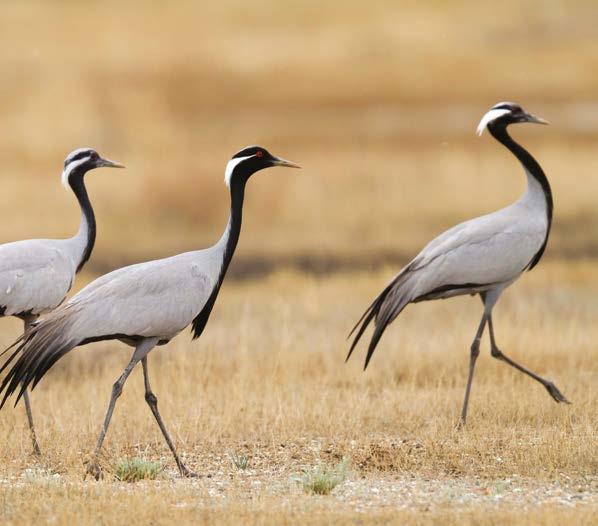
Demoiselle crane Grus virgo
Seasonal migrant in Africa
Eurasian Crane Grus grus
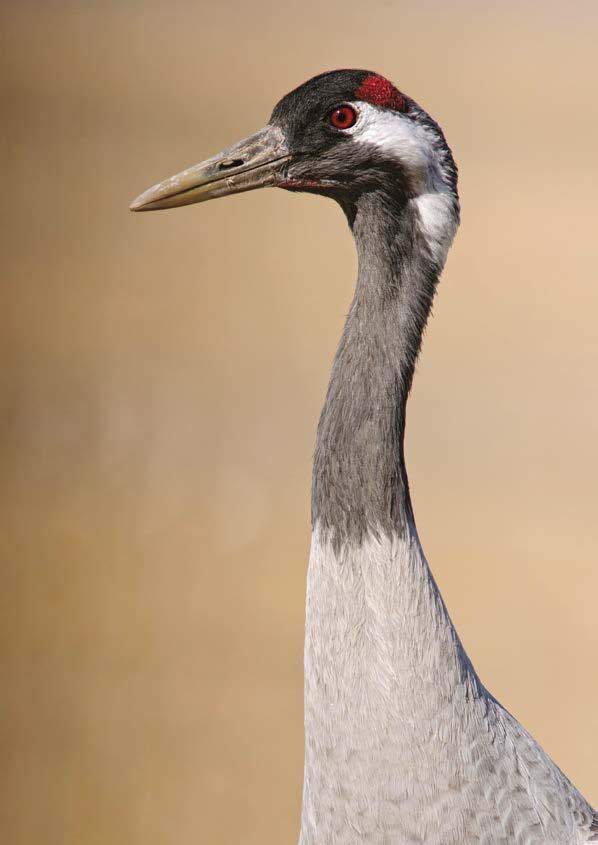
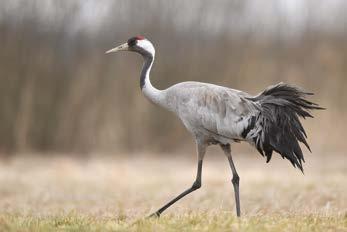
Migrates to Africa only in summer time
References
www.rwandawildlife.org www.umusambivillage.org
IUCN – International Union for the Conservation of Nature. Grey Crowned Crane
Balearica regulorum. https://www.iucnredlist.org/ species/22692046/48105682 https://birdsoftheworld.org/bow/species/grccra1/cur/ introduction
International crane foundation. https://savingcranes.org/
Credits
Front cover, @igihephoto
P1, John Dickens.
P3 Grey Crowned Crane (Balearica regulorum). Masai Mara game reserve, Kenya. Godong / Alamy Stock Photo.
P4 Grey Crowned Crane. Queen Elizabeth national park, Uganda. Ariadne Van Zandbergen / Alamy Stock Photo.
P5 top, p14 right, p16 top, p18 top, p20 top, Will Wilson.
P5 bottom, juvenile & adult. RWCA.
P6, B. Regulorum couple on tree top. Lake Mburo, Uganda. Daniel Lamborn / Alamy Stock Photo.
P7, group in tree, Ngorongoro Crater, Tanzania. Richard Garvey-Williams/ NIS/ Minden Pictures /Alamy Stock Photo.
P8/9. B. regulorum, foraging. Ngorongoro Conservation Area, Tanzania, Africa. travel4pictures / Alamy Stock Photo.
P10. Uganda Conservation Foundation.
P12, Couple, foraging in the water, Serengeti, Tanzania. imageBROKER.com / Alamy Stock Photo.
P14, Crane pair at Umusambi village, Will Wilson Akagera National Park, Drew Bantlin.
P16, GCC taking off, Tanzania. CHOUINARD_DUHAMEL 2016.
P18, Pair courting, Steve Potter photography.
P19, B. regulorum, at nest, Kenya. Danita Delimont / Alamy Stock Photo.
P20, Will Wilson.
P21 B. regulorum dancing, Kenya. Ivan Kuzmin / Alamy Stock Photo.
P21, audio recording of grey crowned crane by Claude Chappuis; Cornell Lab of Ornithology | Macaulay Library.
P22. Grey crowned crane feeding, Amboseli, Kenya, Michele Burgess / Alamy Stock Photo.
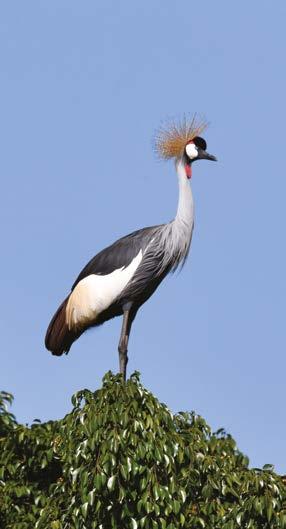
P28, B. regulorum portrait, blickwinkel / Alamy Stock Photo. P29, 2 adults flying, Tanzania, James Hager/Alamy.
P31, Rwanda, Yves Grau/iStock.
Eurasian crane feeding. Roger Eritja / Alamy Stock Photo. Portrait, Kiko Alvarez / Alamy Stock Photo.
Wattled crane, pair, Henk Bogaard Istock. Portrait, Mick Taylor / Alamy Stock Photo.
Black crowned crane feeding, Joe Blossom / Alamy Stock Photo. Portrait, Copyright (c) 2024 oliviervanborm100/ Shutterstock.
Blue crane. NeilBradfield Shutterstock.
Demoiselle cranes, blickwinkel / Alamy Stock Photo. Inside back cover, S. Africa, blickwinkel / Alamy Stock Photo. All other photos ©RWCA.

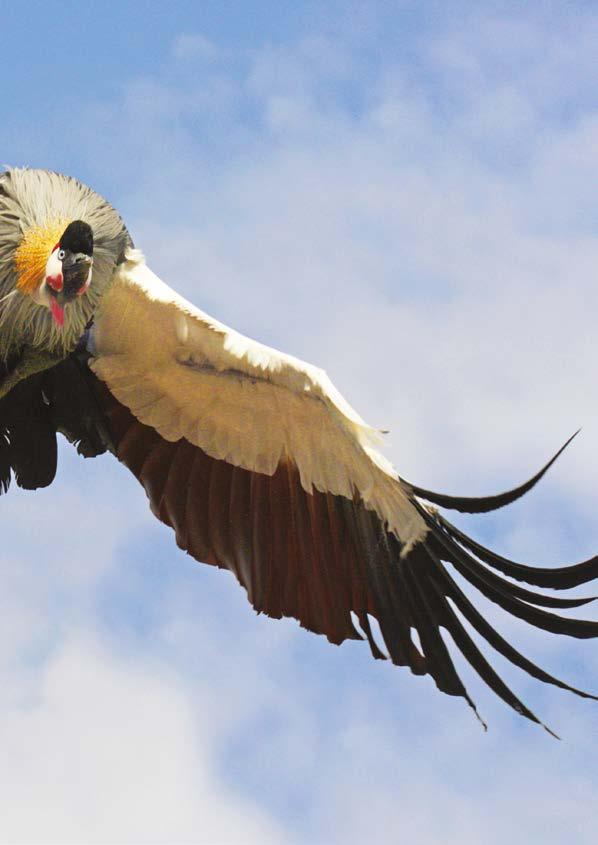


PACE is an education programme of Tusk. We help people understand and solve everyday environmental problems that impact on their wellbeing, and on the wildlife and ecosystems we all depend on. PACE is about helping people connect or reconnect with nature, to understand its inherent value and protect it for future generations.
PACE shares information about the environment and wildlife, and very practical ways in which people are addressing common environmental problems, so that we people, wildlife and our planet have a secure and healthy future. Someone, somewhere has found a solution!
There are ten modules in the PACE pack, this booklet is part of the Living with Wildlife module.
PACE is for students, teachers, community use and general reading. Contact pace@tusk.org | www.paceproject.net
Acknowledgements
Tusk thanks DHL for their significant and generous support of PACE. Their support has been fundamental to the success of PACE to date.

